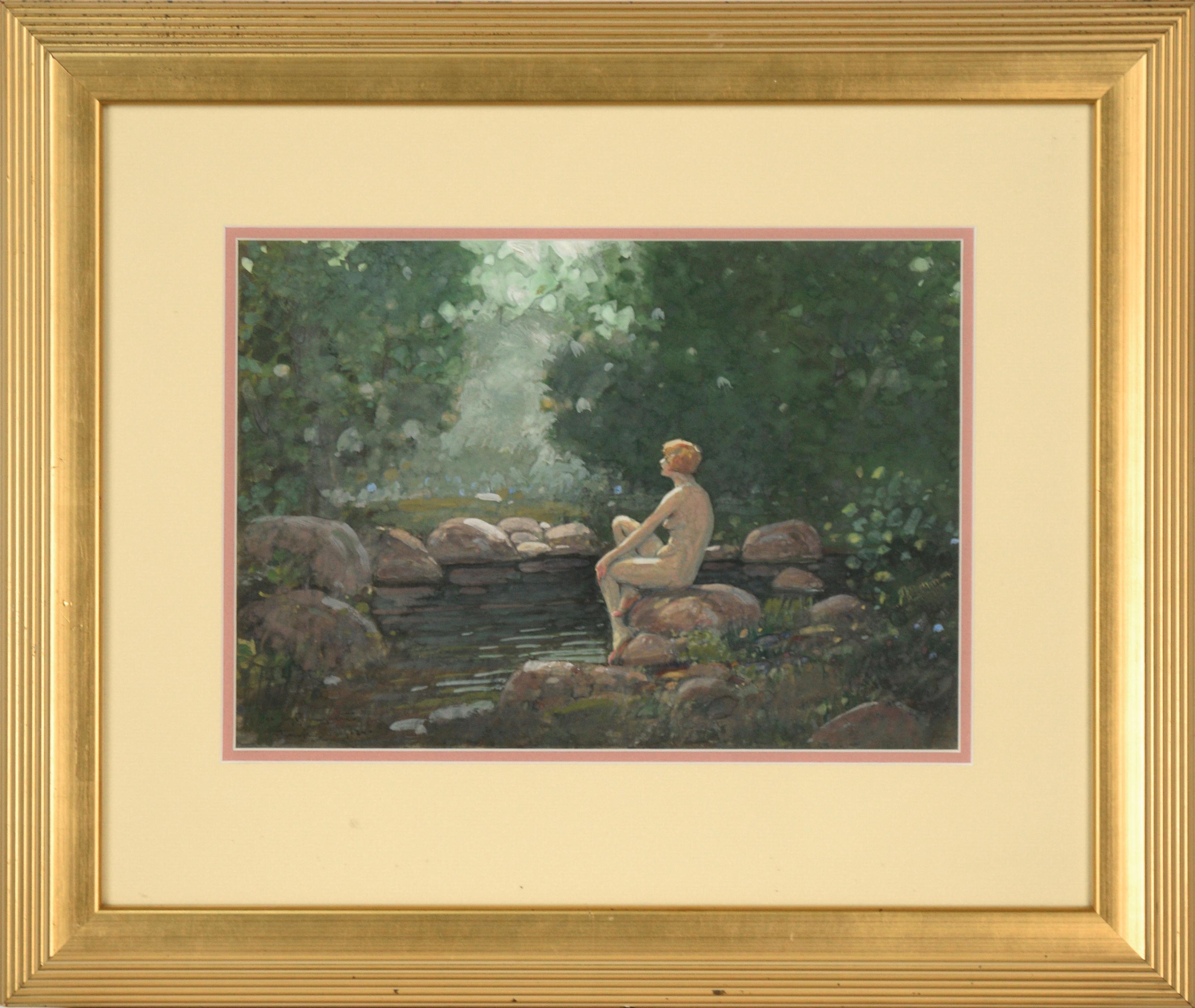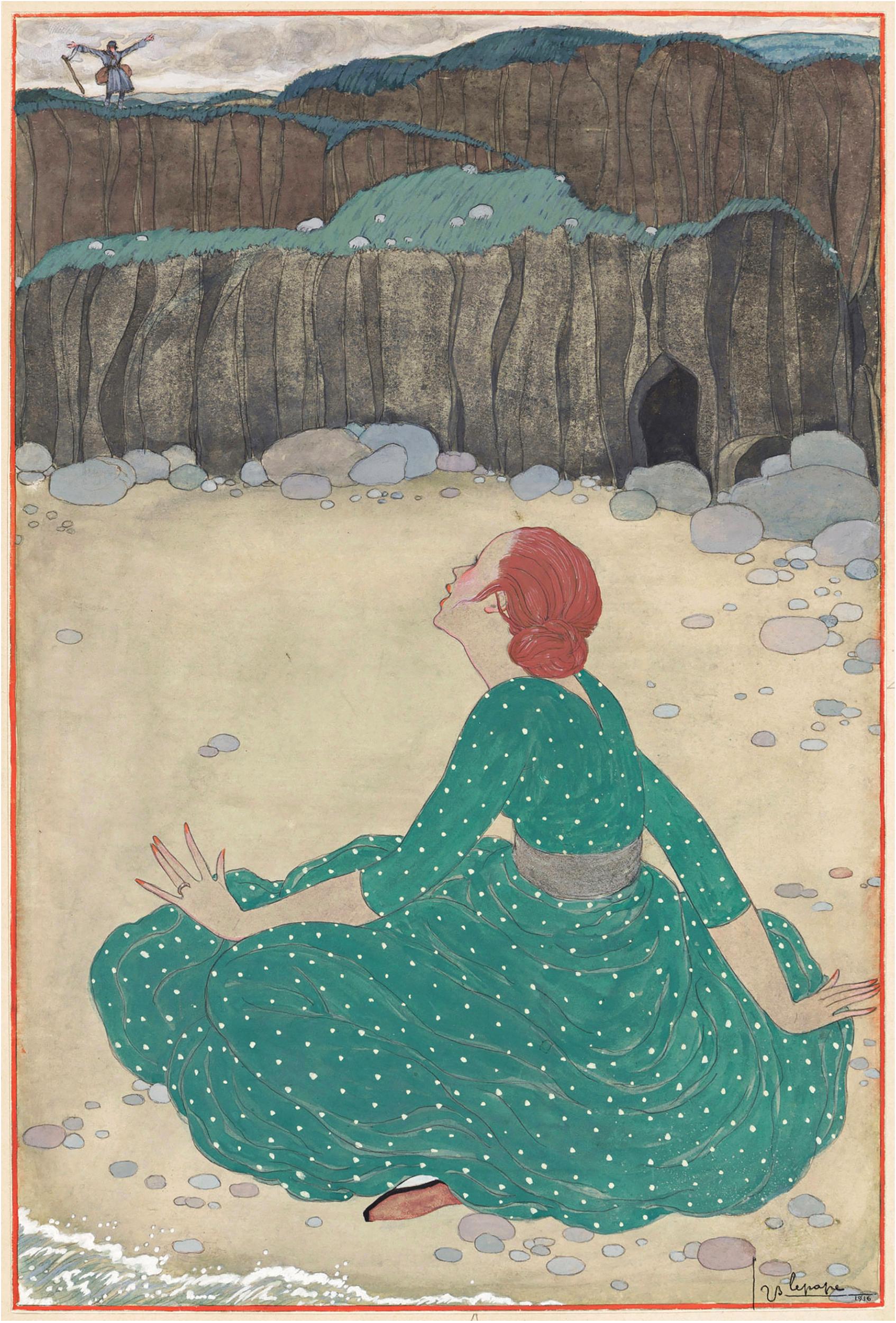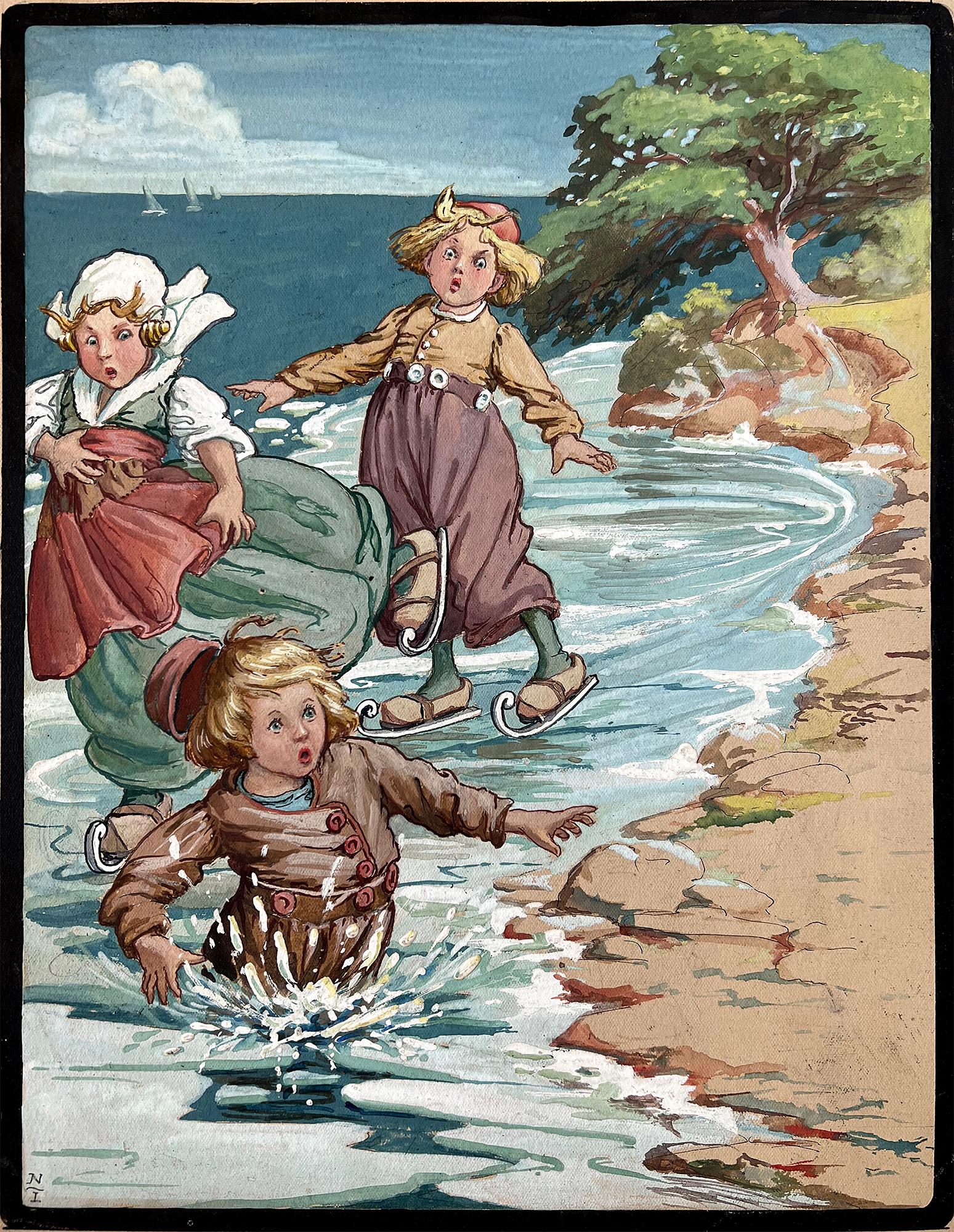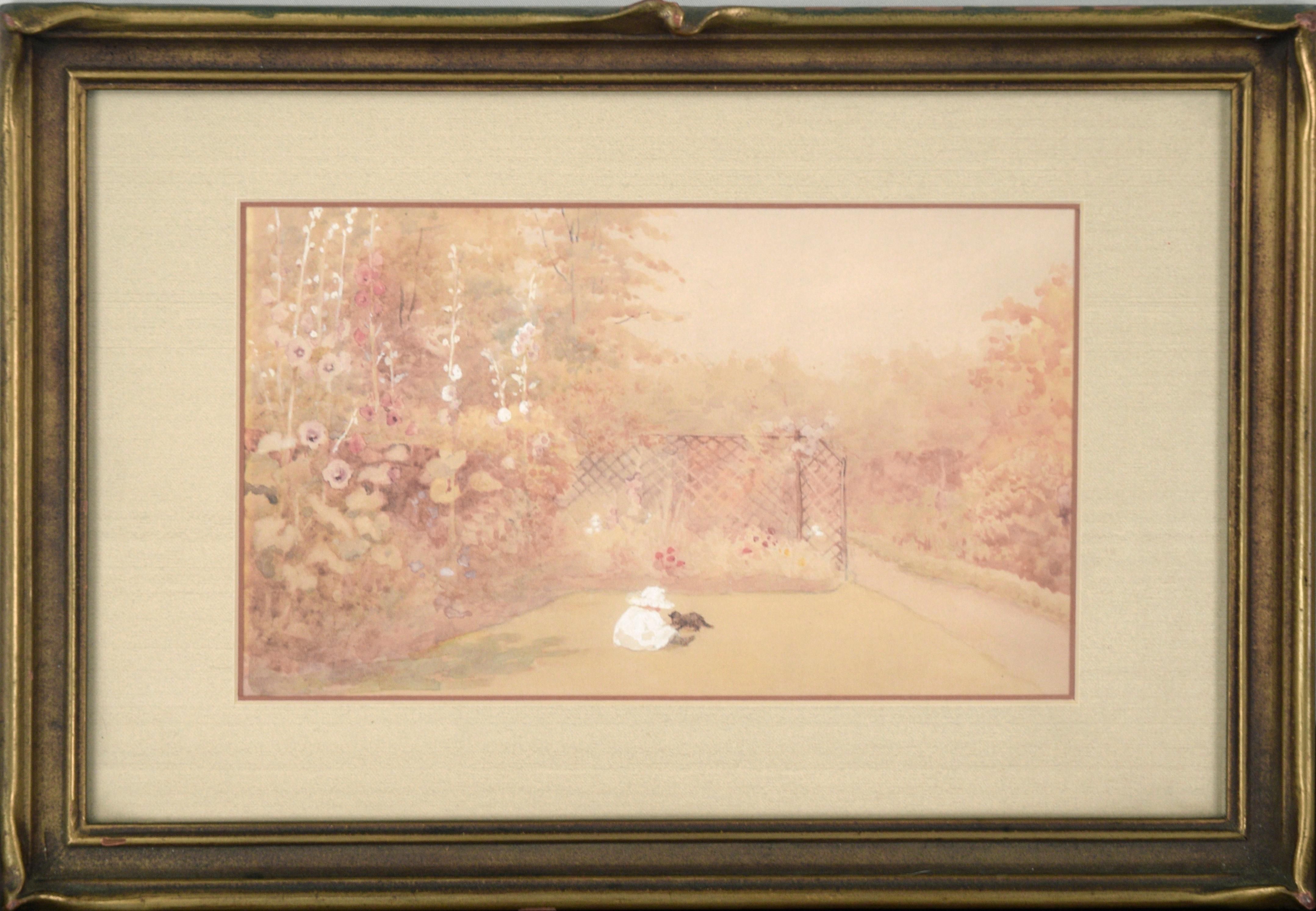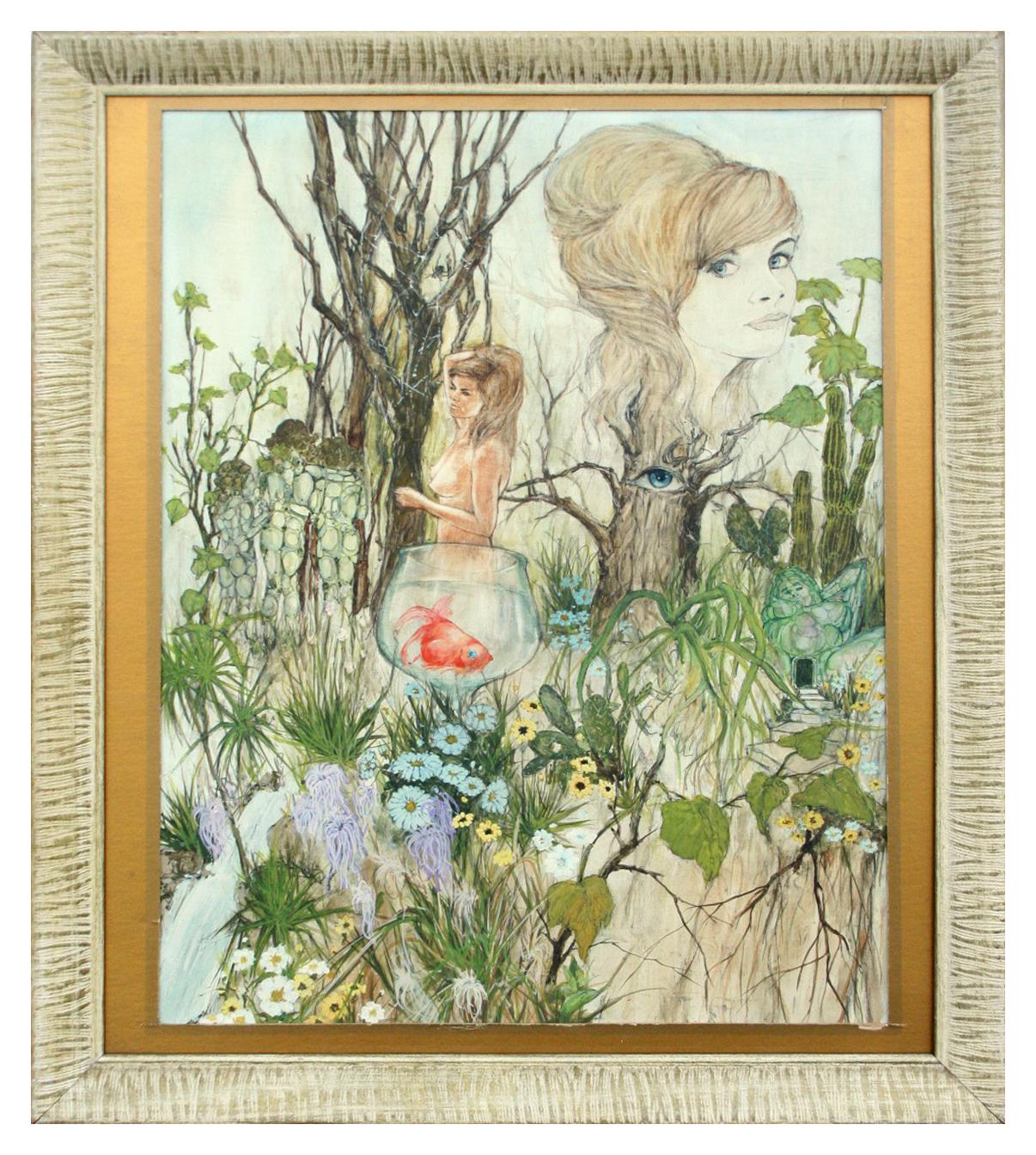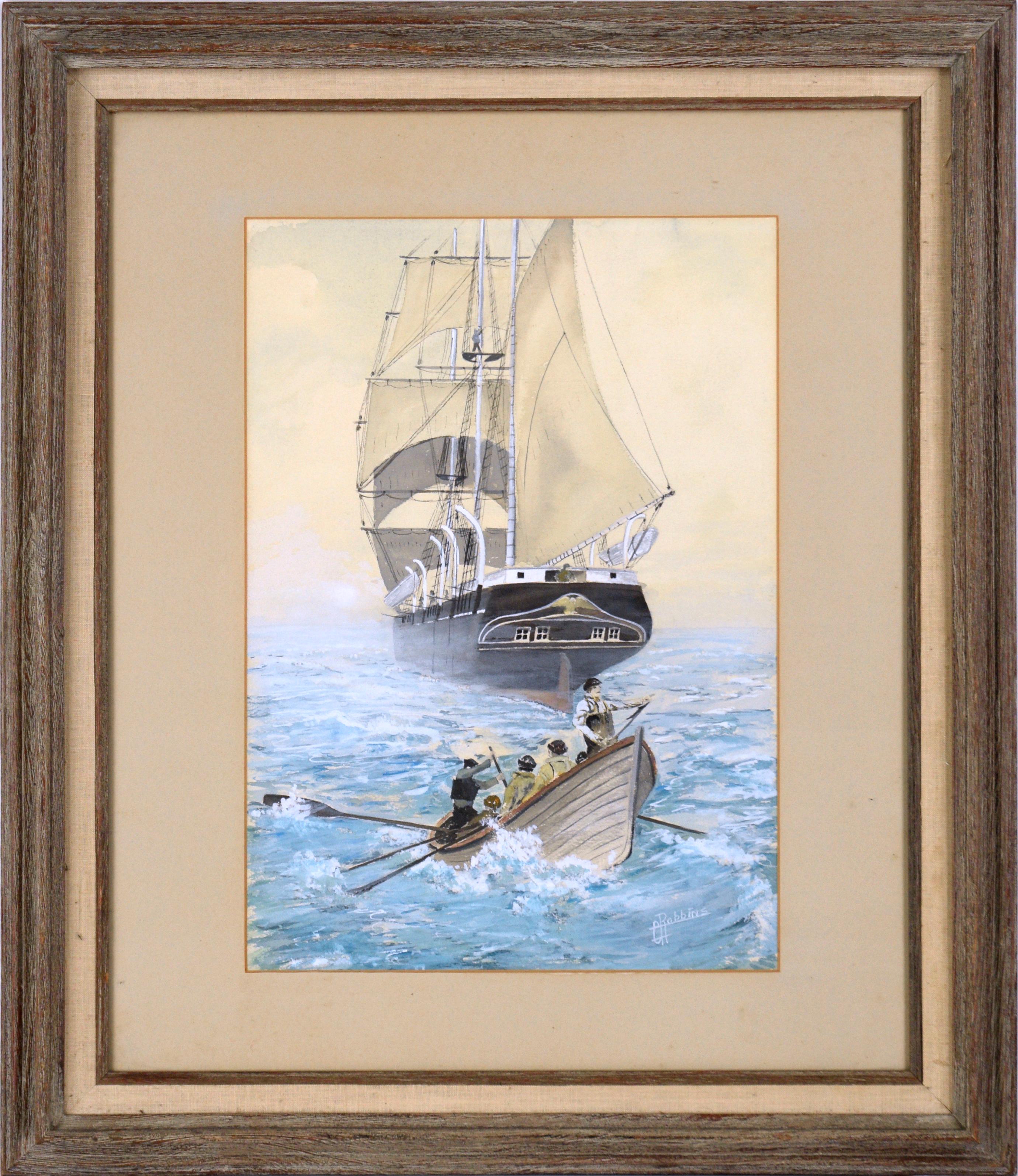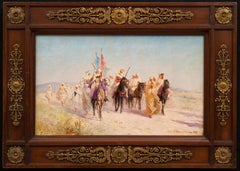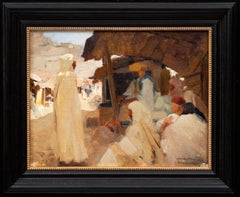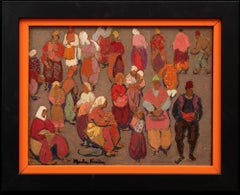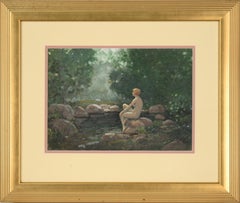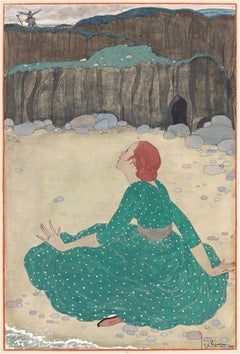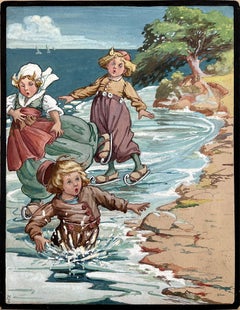Items Similar to Porte Saint-Denis Under the Snow Eugène Galien Laloue (French, 1854-1941)
Want more images or videos?
Request additional images or videos from the seller
1 of 11
Eugène Galien-LalouePorte Saint-Denis Under the Snow Eugène Galien Laloue (French, 1854-1941)
About the Item
Porte Saint-Denis Under the Snow (Porte Saint-Denis Sous la Neige)
Eugène Galien Laloue (French, 1854-1941)
Gouache and watercolor on paper, original carved and gilded frame.
12 ¼ x 7 ½ (18 x 13 ¾ frame) inches
Signed lower left with his pseudonym "F.GIUSTO"
This is sublime Parisian gouache representing the Porte Saint-Denis Under the Snow by Eugène Galien Laloue is richly animated and signed with his rare pseudonym "F.GIUSTO" (the painter used many pseudonyms such as L.DUPUY, J.LIEVIN, E.KERMAINGUY, M.LENOIR, A.MICHEL, L.COURTIER…)
The painting is in perfect condition and retains its original frame, which is also of very high quality and richly detailed. The scene captures the city of Paris in the era of Belle Époque with its numerous entertainments on the boulevard, bright and illuminated store fronts, and the Art Nouveau Metro entrance, etc.
Note the superb white & orange contrast between the snow effect and the lighting.
Eugène Galien-Laloue was a skilled and productive artist, particularly when working in gouache and producing small-scale works. enjoying a considerable reputation in the early years of the 20th century, Laloue painted almost exclusively the most picturesque spots of Paris, notably the Grands-Boulevards. Painting in the happy pre-war period when the city was filled with omnibuses and carriages, Laloue works evoke the atmosphere of turn-of-the-century Paris and retains a clearly important documentary value. Laloue also painted landscapes of Normandy, Seine-et-Marne, Marseilles, Italy and Venice. In 1914 he began painting military scenes. During the 1870s, Laloue painted alongside his friend Charles Jacques in the forests of Fontainebleau
Eugène Galien Laloue was born on December 11, 1854, in Montmartre, the oldest of nine children. His father Charles died when he was sixteen years old, after which he found him work at the local notary, leaving school to fill the position. Shortly after, however, he felt the nationalistic urge to enlist in the military. Quitting his job and faking his name in 1871, he left for military duty which led him through the end of the Franco-Prussian war of 1870-1871. By then he had decided to become a painter.
For such an eager participant in the military, to turn immediately to painting must have been a reaction against the bloody events of the Franco-Prussian war; a way to forget what he had seen. In 1874 he was employed by the French Railway lines as an illustrator, depicting the rail track that was being laid from Paris to the provinces. Concurrently he began painting the surrounding landscapes as well.
While practical, this was unusual “training” for a young art student. His artistic education seemed to come via his other jobs as well. He exhibited for the first time in 1876 at the Museum of Reims. The following year he exhibited for the first time at the annual Parisian Salon. He preferred executing gouaches since they were less time consuming than his oils and brought comparable prices.
Laloue had a reclusive personality, which also may explain the reasons behind his numerous pseudonyms as Eugène Galien Laloue was particularly adept at establishing several identities, since over the course of his career he worked under three pseudonyms: J. Lievin, E. Galiany and L. Dupuy. While these are three confirmed names that he used, there is the possibility that he used other names as well. Even his name “Galien” is questionable, since on occasion he spelled it with one “l” and on his birth certificate it is spelled “Gallien”. Being contractually bound to paint for a gallery, this may have also necessitated desire for adopting numerous pseudonyms.
Despite his reclusive nature, Laloue depicted Paris and the surrounding landscape with his cool palette; in doing so he balanced his architectural interest in Paris with several landscape views and was an equally if not more proficient draughtsman. He preferred the solitariness of his studio and thus did not paint his works entirely on-site. Unlike many other artists of his day, he did not like to travel and many of his views of other cities or countries were inspired by postcards and photographs; an increasing tendency with many artists as photography became a more established method of use.
The depiction of his natural environment was an interesting theme for an artist who did not necessarily seek to connect with nature and while painting en plein-air. Laloue “hated to walk in any mud and even a blade of grass bothered him.” (Noë Willer, Eugène Galien-Laloue: 1854-1941, New York: Alexander Kahan, 1999, pg. 16)
“He was not eccentric but always conservative, practically a royalist. He was obsessed with his painting. In his private life he found simplicity alluring: he married three sisters, one after the other (beginning with the youngest and ending with the oldest). They had all lived next door to him. He lived a monastic life. All worldly pursuits, games, alcohol, the pleasure of the flesh were not for him. Riding his bicycle to places in Paris to paint was his only physical exercise.”
Laloue was more concerned with the sale of his paintings than the associating with his contemporaries who were working in the same manner. He kept scrupulous notes regardless of the fact that he sold each painting for the same price. In 1889t he took a five-year sabbatical, during which time his daughter was born; he returned to the exhibition at the Paris Salon in 1904. During the first two decades of the twentieth century, Laloue also exhibited at Dijon, Orléans, Versailles, Roubaix, Saint Etienne, Bordeaux, Monte Carlo, Hautecoeur, Angers. At an exhibition in Saint Quentin, his work received the following review (Willer, pg. 33):
“Once again we mention Mr. Eugène Galien Laloue for his lovely gouaches, as full as oils, which show most picturesquely the popular quarters of Paris.”
As World War I broke out, aside being too old for military service, Laloue was nevertheless exempt from military service because he had volunteered for the Franco-Prussian war. Instead, he took to his canvas and depicted scenes of soldiers in the midst of battle, paying close attention to the setting and other details such as their costumes and the action of their involvement. His own previous military experience must have inspired his depictions, since in his military scenes his figures are given a more prominent role than in either his Parisian scenes or his landscape paintings. He identified with these soldiers.
Galien Laloue continued to paint until 1940 when he broke the arm with which he held his brush.
He moved out of Paris many times to depict the landscapes of Normandy and the surroundings of Barbizon, making his home for a short time in Fontainebleau. While his Parisian scenes were often of the fall and winter, he preferred to document the landscape during the brighter months of spring and summer. He also documented life along the canals and banks of the sea and rivers, showing an interest in maritime exploits. Throughout his career Laloue had become very popular with both French and especially American artists and collectors. Laloue continued to paint the same scenes of Paris throughout his career.
Eugène Galien-Laloue died in his daughter’s house in Chérence, where they had taken refuge at the beginning of the Second World War, on April 18th, 1941. His works of art can be found in numerous important public and private collections around the world.
- Creator:Eugène Galien-Laloue (1854 - 1941, French)
- Dimensions:Height: 13.75 in (34.93 cm)Width: 18 in (45.72 cm)
- Medium:
- Movement & Style:
- Period:
- Condition:The painting and the original frame are in beautiful condition.
- Gallery Location:SANTA FE, NM
- Reference Number:1stDibs: LU1408216341912
About the Seller
5.0
Platinum Seller
Premium sellers with a 4.7+ rating and 24-hour response times
Established in 1995
1stDibs seller since 2020
112 sales on 1stDibs
Typical response time: <1 hour
- ShippingRetrieving quote...Shipping from: Santa Fe, NM
- Return Policy
Authenticity Guarantee
In the unlikely event there’s an issue with an item’s authenticity, contact us within 1 year for a full refund. DetailsMoney-Back Guarantee
If your item is not as described, is damaged in transit, or does not arrive, contact us within 7 days for a full refund. Details24-Hour Cancellation
You have a 24-hour grace period in which to reconsider your purchase, with no questions asked.Vetted Professional Sellers
Our world-class sellers must adhere to strict standards for service and quality, maintaining the integrity of our listings.Price-Match Guarantee
If you find that a seller listed the same item for a lower price elsewhere, we’ll match it.Trusted Global Delivery
Our best-in-class carrier network provides specialized shipping options worldwide, including custom delivery.More From This Seller
View AllOrientalist: "Arabian Horseman" dated 1903 André Chaumière
Located in SANTA FE, NM
"Fantasia of Arabian Horseman" dated 1903
André Chaumière (French, XlX-XX)
Oil on canvas
Handcrafted original wood frame with bronze applique
20 3/4 x 12 3/4 (28 1/2 x 20 frame) inc...
Category
Early 1900s Art Nouveau Figurative Paintings
Materials
Canvas, Oil
Orientalist Painting "Constantine (Algeria) 1893" Claude Firmin-Goy (1864-1944)
Located in SANTA FE, NM
Constantine (Algeria) 1893”
Claude Firmin-Goy
Oil on canvas
12 1/4 x 16 1/2 (16 1/2 x 20 3/4 frame) inches
This bright and luminous work by the Avignon painter Claude Firmin-Goy re...
Category
1890s Art Nouveau Figurative Paintings
Materials
Canvas, Oil
Marine Painting "Trois Pêcheurs" Louis Pastour (France, 1876-1948)
Located in SANTA FE, NM
"Trois Pêcheurs"
Louis Pastour (France, 1876-1948)
Oil on board
Signed l.l.
7 7/8 x 4 7/8 (8 1/8 x 11 1/8 frame) inches
Louis Pastour was called the “...
Category
1930s Post-Impressionist Landscape Paintings
Materials
Oil, Board
$4,000 Sale Price
29% Off
"A Colorful Crowd, Yugoslavia" Jacques Martin-Ferrières (1893-1972)
By Jacques Martin-Ferrières
Located in SANTA FE, NM
"A Colorful Crowd, Yugoslavia"
Jacques Martin-Ferrières (1893-1972)
Circa 1930s
Oil on panel
17 1/8 x 13 3/4 (frame) inches
A painter remarkable for his highly personal portraits a...
Category
1920s Figurative Paintings
Materials
Oil, Wood Panel
"The Harvesters" Raphaël Dubois aka Chanterou (Belgium, 1888-1960)
Located in SANTA FE, NM
"The Harvesters"
Raphaël Dubois aka Chanterou (Belgium, 1888-1960)
Signed bottom left under the pseudonym "Chanterou"
Oil on canvas
23 1/2 x 19 1/4 (27 3/4 x 23 3/4 frame) inches
Born in Liege in 1888, he enrolled at the age of fourteen at the Academy of Liege where he studied under Evariste Carpentier...
Category
1920s Landscape Paintings
Materials
Canvas, Oil
"The Bather" Eugène Bégarat (French, 1943)
By Eugène Bégarat
Located in SANTA FE, NM
"The Bather"
Eugène Bégarat (French, 1943)
Gouache
11 1/2 x 9 1/2 (21 x 19 frame) inches
Eugène Bégarat was born in 1943. At the age of seventeen, Bégarat entered the School of Dec...
Category
20th Century French School Figurative Paintings
Materials
Gouache
You May Also Like
Lady by the Pond, 1920's Art Nouveau Nude Figurative Landscape
By John Jay Baumgartner
Located in Soquel, CA
Delicate and vibrant mid-1920's depiction of a nude woman sitting on the edge of a bathing pool by John Jay Baumgartner (American, 1865-1946). Soft light filters through dense foliag...
Category
1920s Art Nouveau Landscape Paintings
Materials
Gouache, Laid Paper
Art Nouveau Woman on Beach in Green Dress Romantic Story "Le Retour"
By Georges Lepape
Located in Miami, FL
In this painting, Art Nouveau French illustrator Georges Lepape depicts a high moment of personal drama. He exquisitely renders a beautiful yet solitary woman sitting on the beach...
Category
1910s Art Nouveau Figurative Paintings
Materials
Silver
Mother Goose Gems Book - Three Dutch Children - Female Artist
Located in Miami, FL
Sarah Noble Ives, artist (1864-1944). Original drawing of three Dutch children, with an ink inscription reading: “Full Page / 6 Buff / Three children sliding on the ice / upon a summer’s day” above image. Ink, watercolor, and gouache on linen/board. Illustration for Mother Goose...
Category
1910s Art Nouveau Figurative Paintings
Materials
Ink, Watercolor, Gouache, Board
Playing in the Garden with a Cat - Landscape
Located in Soquel, CA
Restrained landscape with a child playing with a cat by an unknown artist. Although nearly monochromatic, there is exquisite details in the foliage in the foreground. to the left. In...
Category
Mid-20th Century Romantic Landscape Paintings
Materials
Paper, Gouache
Woodland Fancy, Mid-Century Fantastical Figurative Landscape 1969
Located in Soquel, CA
Unique and fantastical mid-century painting of a nude figure standing in front of a fish in the forest surrounded by flowers, plants, and a portrait by Kenneth Fong...
Category
1960s Surrealist Figurative Paintings
Materials
Paper, Gouache
$540 Sale Price
20% Off
Rowing to Shore - Nautical Seascape in Gouache on Paper
Located in Soquel, CA
Noble nautical scene of a small rowboat coming to shore from a larger sailing vessel by George A. Robbins (American, 1918-2010). In the foreground, sever...
Category
Late 20th Century American Realist Landscape Paintings
Materials
Paper, Gouache
